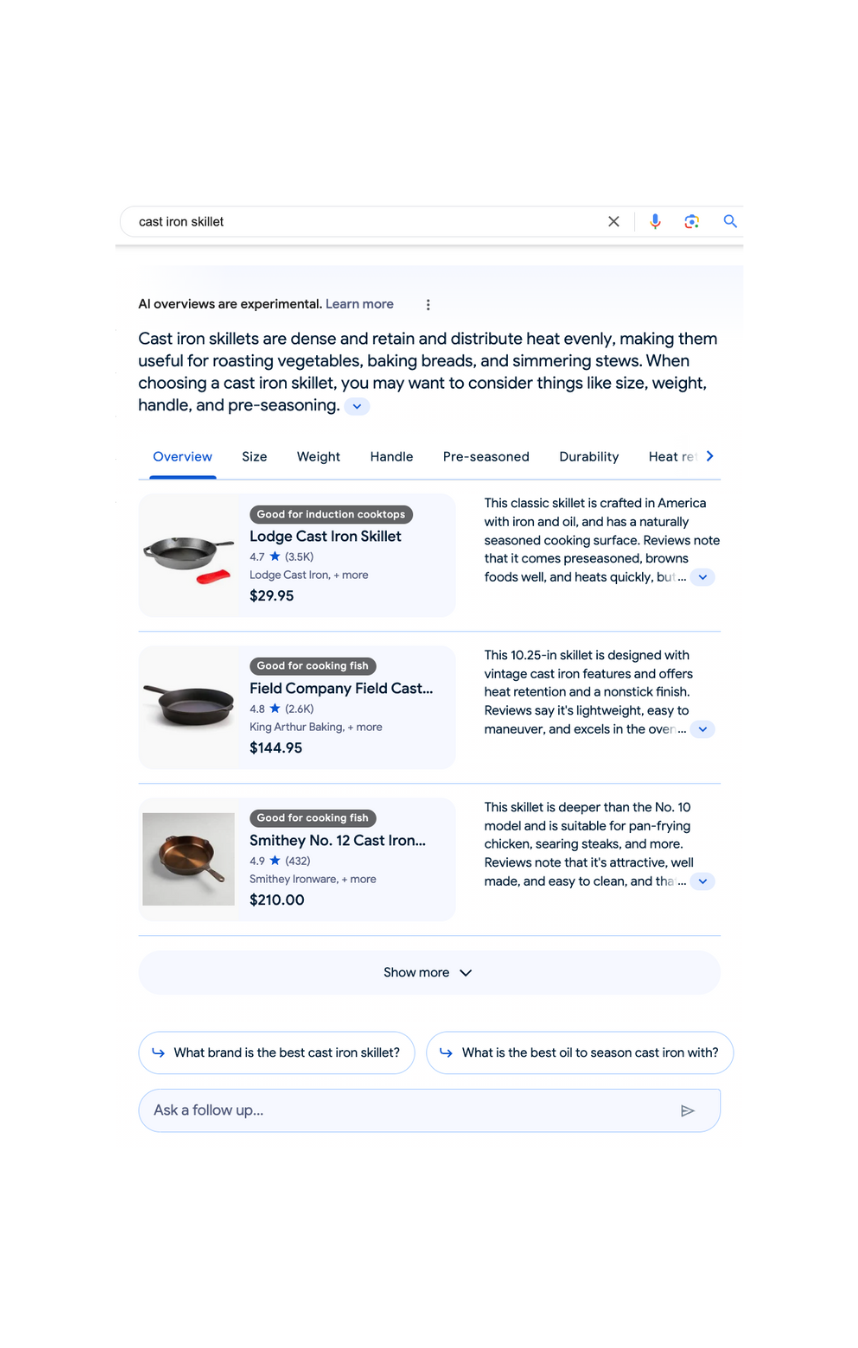Say goodbye to the SERP as we know it: Preparing for Google’s SGE launch
Over the last year or so, Google has been testing its latest major iteration of the search engine results page (SERP), called Search Generative Experience (SGE). For months, only a small subset of users have had the opportunity to opt into the AI-powered experience. But as the rumored full roll-out approaches, it promises to be a seismic shift in search results, affecting all brands’ SEO and SEA strategies.
As this change ticks closer and closer, should you change marketing, content, or media efforts when AI comes to page one?
SGE is not the “Old Google” algorithm, so expect volatility
When it comes to source eligibility and preference with SGE, throw out Google’s old ranking and quality-assessing algorithms. Buying backlinks to your content won’t trick Google into thinking it has authority, and you won’t be able to spend your way into being included in SGE results via paid media.
Here are a few early data points that highlight the shake-up to legacy TOFU, MOFU, and BOFU models:
- Full funnel changes: SGE significantly streamlines the discovery and purchase process across Google Search. By serving products to users and allowing them to compare products, read reviews, and ask further questions directly on the SERP, SGE limits website CTR until the searcher is ready to convert.
- No guarantee of rank: According to recent studies, 43% of sources cited by SGE do not rank on page one for their corresponding queries.
- Top domains lose visibility: According to recent studies, only 17% of SGE results cite information from sources that rank #1-3 for their given queries.
Altogether, this means the search landscape could be volatile in the short term, and brands should start doing cardio if they want to remain agile.
Organic search ranking does not equate to SGE success
Key takeaway: Brands should not count on their existing keyword portfolio to sustain them in a world where SGE is part of the default search experience.
Why? The AI-fueling SGE does not simply choose high-ranking websites as the sources it cites most frequently in the results carousels. It’s important to avoid a “wait and see” approach to SGE operating under the belief that a strong non-brand keyword portfolio will offset potential traffic loss.
It’s likely that click-through rates for the highest performers—or sites ranking within the top three spots—will feel the heaviest impact from SGE, given the AI carousel’s dominant above-the-fold presence and current source preferences.
e-Commerce queries heavily impacted in this “New Google” era
Queries with e-commerce buying signals, from discovery to conversion phases, will likely experience strong turbulence when SGE fully goes live.

- During the testing period, studies found SGE results appeared for 87% of all e-commerce queries reviewed.
- SGE appeared 98% of the time for organic search queries with an associated high CPC ($5 and above).
- For most queries, SGE replaces featured snippets and does so.
- For e-commerce searches, CPC is highly correlated to SGE inclusion on the SERP (at least for now).
In the example, at left, the searcher’s product discovery, comparison, and evaluation process can all happen right on the SERP, all with products from brands that do not rank on page one for the query (as of April 2024).
SGE results take up the entire above-the-fold space, leaving less real estate for currently ranking pages to receive impressions and, ultimately, impacting traffic. For a keyword like “cast iron skillet” with ~90k searches per month, SGE will likely cause significant website traffic volatility for brands ranked on page one.
Organic competitors will change overnight when SGE goes live
Brands long marooned on the second page of Google search results could gain new life as SGE sources at the top of page one. Previously dominant brands will need to reevaluate their search competitors as well as the strategies they’ve employed to reach and remain in those prominent ranking positions.
Key Takeaway: Look at what startup brands are doing to get noticed right now, especially in e-commerce. These companies could soon be leading against slower enterprise retailers.
Once SGE launches, even the value of organic ranking positions will change. CTR fluctuations will cause traffic to shift around the SERP. Every traffic and revenue projection for the year must change—and it should.

Take a look at the data we pulled together for an example SGE Risk Assessment.
What do we notice? For informational queries reviewed, SGE is changing the estimated CTR for position #1 by 3%, with varying impacts dependent on search volume. The impact on commercial and transactional queries is approximately the same in the data we reviewed.
Hypothesis: We anticipate the impact SGE will have on CTRs will vary by search intent, vertical, and which SGE attributes are displayed.
In the example assessment, the brand stands to lose approximately 8,500 organic visitors per month due to SGE inclusion in their page one, non-brand organic keyword portfolio. Over 12 months, about 102,000 organic visitors will be displaced. Clearly, a 3% change can be far more detrimental than it sounds.
The new goal: “source eligible” and “source preferred” content
Optimizing for the SGE source carousel and its generated content requires a change in SEO verbiage. You are not trying to “rank” for SGE—throw that nomenclature away.
Instead, use these terms to shift your thinking around the Search Generative Experience and your tactical approach to optimization:
- Source eligible: A page or domain that is in the running for SGE to choose all or a portion of its content as part of an AI-generated query response.
- Source preferred: A given domain or page that is both eligible for inclusion in SGE results and preferred by the AI when generating its responses to queries.
So, how do we begin to make any domain or just a single URL “source preferred” by artificial intelligence?
SGE wants fast, lightweight websites as sources
To start, conduct a thorough review of a domain from a technical SEO perspective; specifically how it leverages JavaScript to render its content. All the data collected thus far points to SGE preferring fast sites over those with heavy JavaScript compilation times (hat tip to the folks at Onely for figuring this out).
We’re all about to get obsessed with page speed once again. Based on source preferred websites’ performance against their source ineligible competitors, brands should …
- Eliminate bloated scripts: Source-preferred sites had 9.5% shorter script evaluation times, i.e. smaller JS payloads overall as part of their content loading processes.
- Don’t delay important stuff: Source-preferred sites had 15% shorter V8 compilation time, meaning the AI prefers JavaScript that it can begin parsing immediately.
Together, this data suggests that prioritizing page speed is a potential ROI-positive activity for technical SEO in ways it hasn’t been before.
Orient page content to task completion
Marketers have heard this one for years, from both SEO consultants and even Google itself: Just write content that helps humans solve problems. And this time, we really mean it! SGE has no time for slow websites and pages riddled with useless, “optimized” content.
If the purpose of a page is to help a human do a thing, then its content should get to the point—fast. All the best practices (bullet points, numbered lists, avoiding passive voice, etc.) for content remain the same with SGE, but the consequences are more binary.
Want to hide the ball with page content so leads will contact you? SGE won’t use the page. Do your category pages rely on fat paragraphs of keyword-stuffed text at the bottom to rank? Don’t count on AI liking it.
From video to structured data
With SGE effectively building category pages in search results via free listings from Google Merchant Center (GMC), product detail pages (PDPs) are about to have a real opportunity for organic visibility. To get the best performance out of PDPs in an AI world with Google, focus on the following items:
- Product structured data: Ensure offers and related product markup via schema.org are 100% error free for all indexable PDPs included in GMC feeds.
- Clear product descriptions: Provide product descriptions that include features, sizing, and materials in easy-to-understand formatting.
- Spruce up the GMC feed: Give shopping feeds a once-over, making sure the data sent to GMC is error free as well.
- Speed matters here, too. Remember JavaScript load times. HTML content that loads fast is more likely to be preferred as a source.
Follow-up queries suggested by SGE are a great opportunity to focus on content that’s e-commerce adjacent to support product and category pages. Gemini, and other systems running with SGE, can pull content snippets that the AI considers preferable to answer searcher follow-ups, giving a single post multiple chances to appear for a single searcher journey.
- Task completion: Content must solve problems for searchers quickly (so prioritize bullet points, scannability, etc.) and leverage all appropriate media (images, video, HTML text) to satisfy search intent.
- No featured snippets: SGE content will likely replace Featured Snippets for all search results where it appears.
- Don’t abandon long form: In-depth, topically relevant content remains important as SGE can pull data points it considers valuable for multiple queries.
- Maximize opportunities: Clickable, follow-up questions will be an optimization opportunity.
- Strength of video: 71% of SGE snippets contain a YouTube video as part of its cited source material.
Gearing up for SGE
So what are the most important things brands and marketing leaders should take away from Google’s anticipated full launch of the Search Generative Experience? Here’s what we think:
- Prepare for volatility: The Search Generative Experience represents a fundamental change in how Google presents search results, which will likely result in traffic sent by Google across search intents.
- Speed is key: Content that’s less dependent on JavaScript for visual render, and therefore is faster to load, achieves better visibility in an SGE world.
- Content must be human-oriented: SGE will likely ignore content that its systems deem as not helpful to searchers in making informed decisions. Content written for search engine bots alone has no utility.
- New competitors incoming: SGE promises to bring new brands and info to a prominent position in Google search results, causing an emergence of new competitors.
Questions?
Sr. Director – SEO


